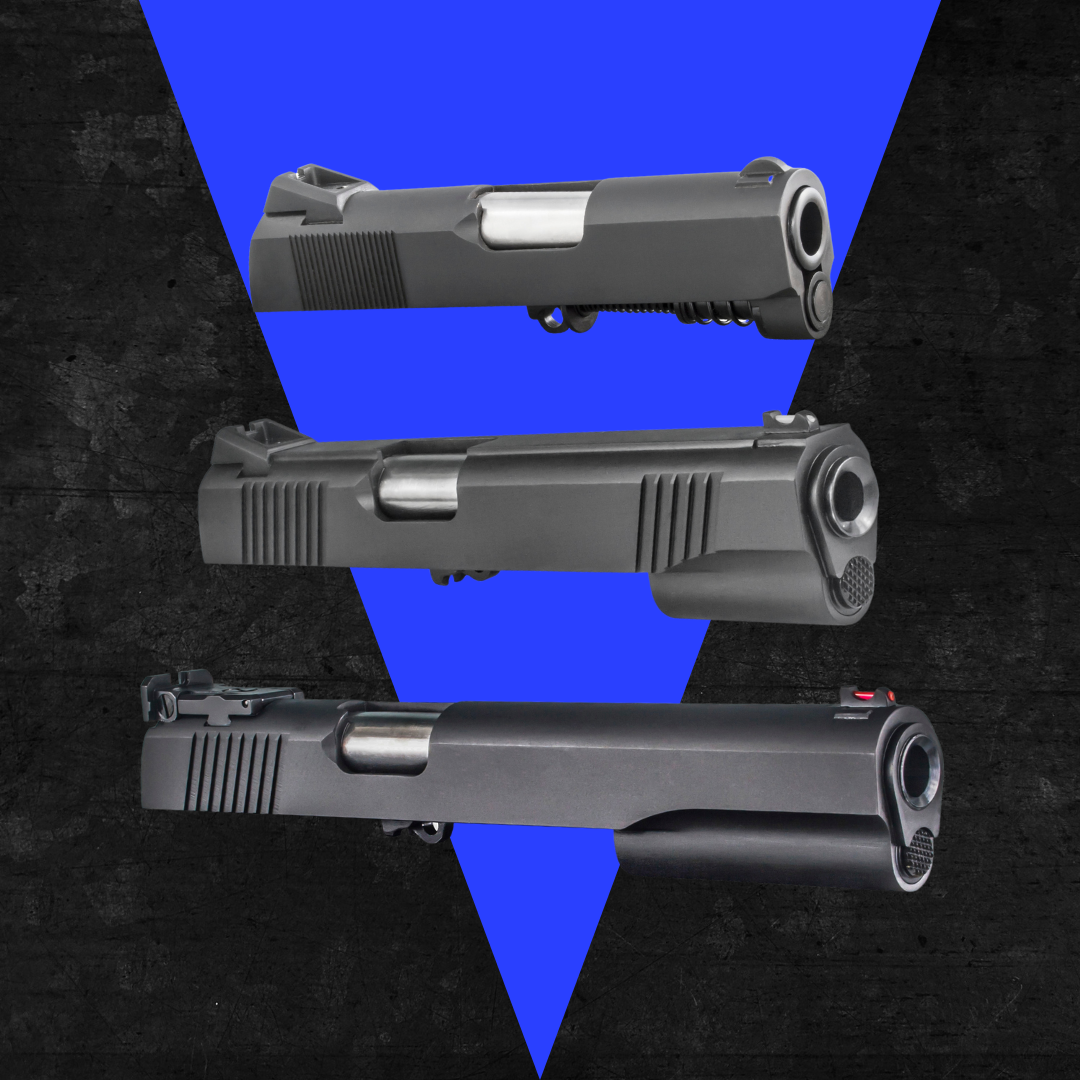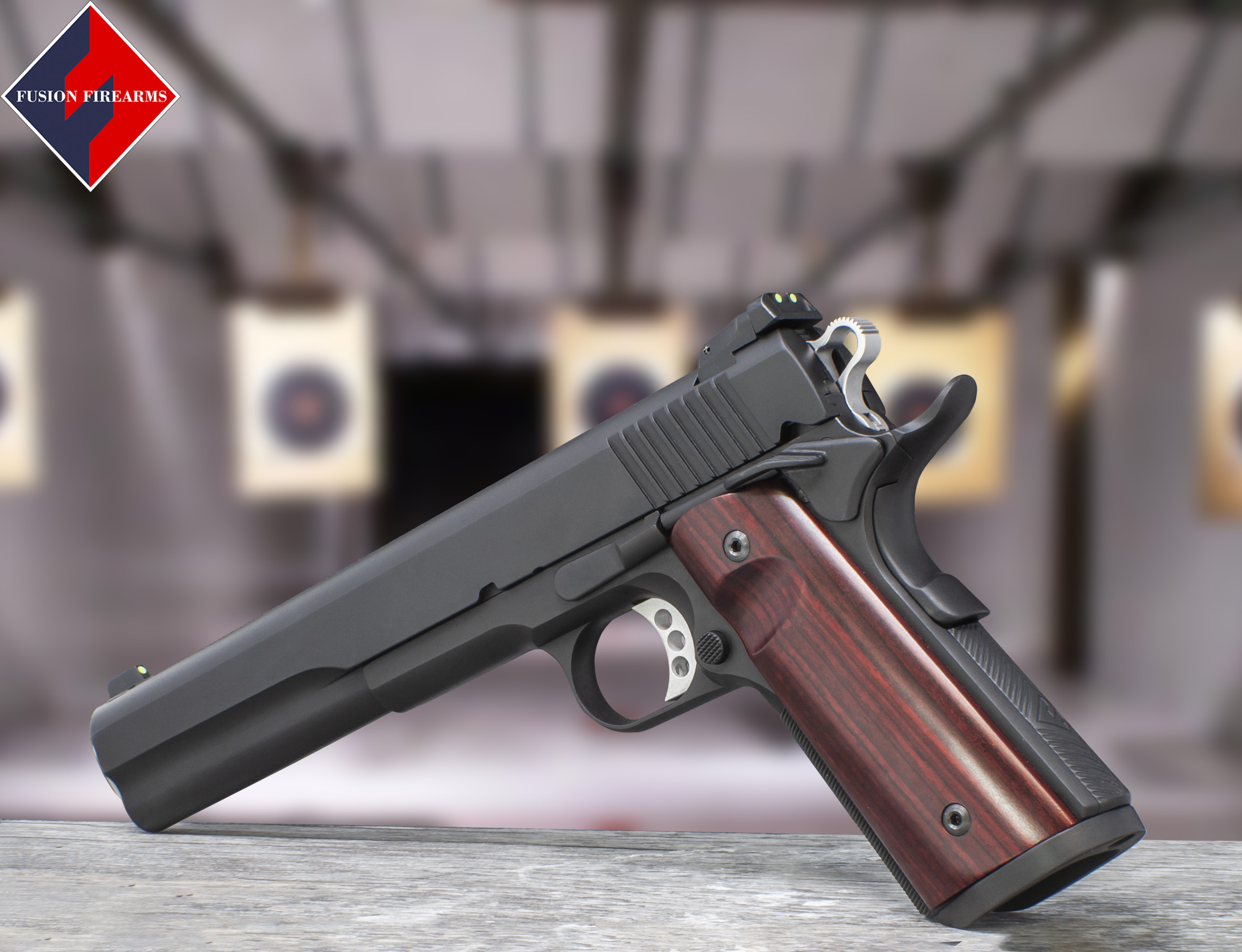- Category
- Home
- 1911 Parts
- Slide Parts
Slide Parts
The 1911 pistol is a classic and widely popular firearm that has been used for over a century. Its design and operation make it an ideal choice for many shooters. The 1911 pistol is made up of several different parts, including the slide, which is one of the most important parts of the pistol.
What are 1911 Pistol Slide Parts?
The pistol slide houses the gun’s barrel, extractor, guide rod, recoil spring, firing pin, firing pin spring, and the firing pin stop plate. The main reason it got the name “Slide” is because the recoil of a semi-automatic handgun causes it to slide backward. The motion ejects the fired casing, cocks the hammer, and loads the next round into the chamber.
Pistol slides also include a slide lock for optimal functioning. The slide lock holds the slide in place if you’ve already fired your last bullet from the magazine. The slide stop or slide lock will release when you apply downward pressure to it.
All of these components work together in a complex yet highly efficient mechanical system, demonstrating the innovative engineering of the 1911 pistol design.
What are the Functions and Types of Pistol Slide Parts?
It is crucial to ensure you have a simple and functional slide before firing your weapon. The slide plays several critical roles when engaging your gun, and this section explains some;
Eject Spent Casing
The 1911 pistol uses a toggle-link mechanism to control the movement of the slide during the ejection process. When a round is fired, the pressure from the explosion pushes the slide back, causing the toggle links to rotate downward. This downward movement unlocks the breech and allows the slide to continue moving back, extracting the spent casing from the chamber. The casing is then pushed out of the ejection port by the ejector, a small metal component located inside the frame. As the slide continues to move back, the recoil spring compresses and then returns the slide to its original position, chambering a new round from the magazine. This cycle repeats with each subsequent shot, allowing the 1911 to quickly and efficiently eject spent casings and reload new rounds.
Cock the Hammer
The 1911 pistol cocks the hammer as the slide moves back during the recoil process. As the slide moves back, it also moves the hammer strut, which is connected to the hammer, back with it. This causes the hammer to rotate slightly, cocking it back into the ready-to-fire position. When the slide returns to its original position, the hammer is fully cocked and ready to be fired again. Additionally, the 1911 pistol can also be manually cocked by pulling the hammer back to the cocked position with the thumb. This is known as "thumb-cocking" the hammer.
Loading Another Cartridge
The 1911 pistol loads another cartridge from the magazine through the use of a magazine spring and follower. The magazine is inserted into the grip of the pistol and is held in place by a magazine catch. When a round is fired, the recoil process causes the slide to move back, which extracts the spent casing and loads a new round from the magazine into the chamber. This is accomplished through the use of the magazine spring, which pushes the rounds in the magazine upward, and the follower, which helps guide the rounds into position for feeding into the chamber. When the slide returns to its original position, the new round is fully chambered and ready to be fired. You will know you are out of ammo in a 1911 pistol when the slide locks back after the last round in the magazine has been fired. This is a safety feature that alerts the shooter that the pistol is empty and needs to be reloaded. Additionally, the magazine follower, which helps guide the rounds into position for feeding, can also be seen and felt through the ejection port. If the follower is visible, it means the magazine is empty and needs to be reloaded. Another indicator that the 1911 is out of ammo is if the trigger pull is longer and lighter than normal, as this indicates that the hammer is falling on an empty chamber.
How Does a 1911 Pistol Slide Work?
The 1911 pistol slide is a crucial component of the pistol's design and plays a vital role in the firearm's functionality. The slide works by using the force of recoil to extract spent casings and reload new rounds after each shot is fired. When a round is fired, the recoil from the explosion causes the slide to move back, starting the cycle of extraction and reloading.
The movement of the slide back extracts the spent casing from the chamber, pushing it out of the ejection port. This is achieved through the use of the extractor, a small metal component located on the slide, which grips the casing and pulls it out of the chamber. The movement of the slide also compresses the recoil spring, which is stored in a tube within the frame of the pistol.
Once the slide reaches the end of its rearward travel, the compressed recoil spring returns the slide to its original position, chambering a new round from the magazine in the process. This is achieved through the use of the feed ramp, a slanted surface located at the bottom of the barrel, which helps guide the new round into the chamber.
In addition to performing the critical tasks of extraction and reloading, the slide also houses the barrel, which moves back and forth with the slide during the recoil process. This ensures that the barrel and slide are properly aligned for each shot, which helps to maintain accuracy and reliability. The proper alignment of the barrel and slide is critical to the functioning of the 1911 pistol, as misalignment can cause malfunctions and negatively impact accuracy.
The 1911 pistol slide is designed to be durable and reliable, as it is subjected to significant forces with each shot fired. It is made from high-quality materials, such as steel or aluminum, to ensure that it can withstand the rigors of repeated use. The slide is an integral part of the 1911 pistol's design, and its proper functioning is essential for the pistol to operate correctly. The 1911 pistol slide is critical to the functioning of the pistol, as it performs several important functions, including extracting spent casings, reloading new rounds, and ensuring proper barrel alignment.
It would be wise to understand your pistol better and know how to use it.
What are Different PISTOL Slide Parts Provided by Fusion Arms?
The good thing about pistol slide parts is that several retailers offer readily-available replacement options. Fusion firearms are among the leading firearm retailers, with hundreds of firearm parts you can consider for your pistol. There are different types of 1911 pistol slides to consider from our comprehensive catalog.
Some of our best sellers are 1911 slide parts. Perfect-fit parts exist for the different slide designs, from the commander and government slides to the full-length prospect. In addition to a rich catalog, we offer competitive prices and out-of-this-world discounts.
Conclusion
You must understand the importance of a handgun slide to improve your handling skills. Pistol slides help release spent bullet casings, reload the chamber, and hold when the magazine is empty. Contact us today if you have questions about your pistol slide or want to find a worthy replacement.
Frequently Asked Questions:
What is the use of a slide in a gun?
The slide is an integral part of a gun that helps to control the pressure generated each time the firearm is fired. It slides back and forth within the frame, providing for proper feeding and ejection of cartridges or shells.
What is a gun slide made of?
The slide is an integral part of a gun that helps to control the pressure generated each time the firearm is fired. It slides back and forth within the frame, providing for proper feeding and ejection of cartridges or shells.
What is the slide assembly on a pistol?
The slide assembly on a pistol is the mechanism responsible for loading, unloading, and firing the firearm. It consists of several parts, including the slide, barrel, recoil spring, breechblock, extractor, and ejector, all housed within the frame.
How does a gun slide work?
The slide on a gun works by allowing the firearm to cycle rounds. When the trigger is pulled, pressure from the cartridge activates a recoil spring in the frame, which propels the slide back and forth. This movement unlocks the breechblock, allowing a round to be loaded into the barrel, fired, and then ejected through an ejector port.
What is the sliding part of a pistol?
The sliding part of a pistol is commonly referred to as the slide. It is responsible for loading and unloading rounds from the firearm and providing support for all other parts housed within the frame.
Show more Show less
Position
Product Name
Price
View as
Grid
List
Items 1-12 of 126
12
15
30
- To TopShop ByShopping OptionsMy Wish List















